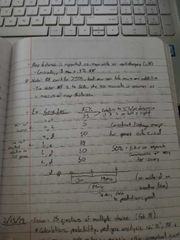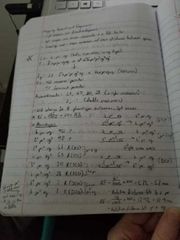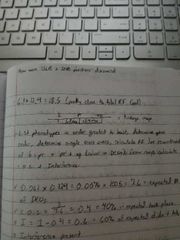![]()
![]()
![]()
Use LEFT and RIGHT arrow keys to navigate between flashcards;
Use UP and DOWN arrow keys to flip the card;
H to show hint;
A reads text to speech;
29 Cards in this Set
- Front
- Back
- 3rd side (hint)
|
In genetics, what is mapping? |
The experimental process of determining the locations (loci) of genes or other segments of DNA along individual chromosomes based on some kind of scale. |
|
|
|
What are the three approaches to genetic mapping? |
1. Cytogenetic map 2. Linkage map 3. Physical map |
|
|
|
Define linkage. |
Two or more genes located on the same chromosome. If they are located close together, they tend to be transmitted together and are therefore considered linked. |
|
|
|
True or false. Linked genes obey the laws of independent assortment, unless crossing over occurs between the two genes. |
False. They do not follow the law of independent assortment unless crossing over occurs between them. |
|
|
|
What happens if the genes are on the same chromosome and crossing over does not occur? |
Testcrossed dihybrids produce only parental offspring. |
|
|
|
What happens if genes are on the same chromosome and crossing over DOES occur? |
Testcrossed dihybrids will produce greater than 50% parental and less than 50% recombinant offspring. |
|
|
|
What is cis conformation? |
When two dominant alleles are on the same homolog. Ex: pr+vg+ on one homolog and prvg on the other. |
|
|
|
What is trans conformation? |
When the dominant alleles are on different homologs. Ex: pr+vg on one homolog and prvg+ on the other. |
|
|
|
What are the three steps to determine if genes are linked? |
1. Testcross with a heterozygous individual for 2+ genes. 2. Look at offspring for recombinant progeny. 3. Perform a Chi-square test. |
|
|
|
What is the null hypothesis for testing for linkage? |
Independent assortment is taking place. If this is true, the genes are non-linked, and a testcross would result in a 1:1:1:1 ratio. |
|
|
|
How do you calculate the estimated distance between two linked genes? What is this measured in? |
Recombination frequency. RF = (total recombinants / total progeny) x 100. This gives you a percentage. RF units are map units. So if you have a 10.7% RF, then the distance between the genes is 10.7 map units. |
|
|
|
True or false, RF can't be greater than 50%, but map units can be. |
True. Map units are additive. However, the closer RF is to 50%, the less accurate it becomes as a measure of map distance.
If RF is 50% or more, assume the genes are on separate chromosomes or are far apart on the same chromosome. |
|
|
|
Study the example in the picture for how to map genes in relation to each other. Remember, start with the genes that have the lowest distance between them and go up from there. |

|
|
|
|
What types of crosses are more advantageous? |
3 point crosses rather than 2 point crosses. |
|
|
|
In a 3 point cross, how do you know which gene is in the middle? |
Look at the double recombinants (they will have the lowest phenotypic appearance). Compare them to parental types (they will have the highest phenotypic appearance). Whichever gene doesn't match the parental genotype is the middle gene. Ex: b pr vg and b+ pr+ vg+ Double Recombinants are: b+ pr vg+ and b pr+ vg. We can see that in the double recombinants, pr is the gene that is the odd man out when compared to the parental input gametes. That means it is in the middle. Remember to always check which gene is in the middle before calculating recombination frequency. |
|
|
|
Study this image to recall how to calculate recombination frequency and map genes with a 3 point cross. |

|

|
|
|
How do you calculate the coefficient of coincidence and the interference? |
coc = number of observed double cross overs / number of expected double cross overs. # of expected double cross overs = decimal RF of one DCO x decimal RF of other DCO. Multiply the result by total number of progeny. I = (1 - coc) x 100. |
|
|
|
What causes recombination interference? |
When a cross over happens in one spot on a chromosome, the likelihood of a crossover nearby is decreased. Shows what percentage of DCOs that did not occur. |
|
|
|
Why do longer regions have higher RFs? |
There is more room for crossovers to happen. |
|
|
|
What is a molecular marker? |
A segment of DNA found at a specific site along a chromosome that has properties that enable it to be uniquely recognized using molecular techniques. |
|
|
|
What are the two main types of molecular markers? |
1. Single nucleotide polymorphisms (SNPs). 2. Simple sequence length polymorphisms (SSLPs) Most don't determine a phenotype. |
|
|
|
What are the two ways you can detect SNPs? |
1. By sequencing a segment of DNA in homologous chromosomes and comparing them. 2. Performing a restriction fragment length polymorphism (RFLP) analysis. |
|
|
|
What are RFLPs? |
Different lengths of DNA created by restriction enzymes such as endonuclease. |
|
|
|
What is the advantage of performing a Southern blot analysis over an electrophoresis analysis of a RFLP? |
The Southern blot can detect specific, and therefore fewer, DNA fragments using radiolabeled probes. |
|
|
|
Which of the following is NOT true of restriction fragment length polymorphisms? 1. They are generated by endonuclease 2. They can be analyzed by electrophoresis 3. They can by analyzed by Southern blot 4. They may arise due to a SNP 5. They are a form of simple sequence length polymorphisms? |
#5. They are not a type of SSLP. |
|
|
|
In gel electrophoresis, DNA fragments travel to the ______ anode because DNA is ______. |
Positively charged anode DNA is negatively charged. |
|
|
|
What are the two types of simple sequence length polymorphisms? |
1. Minisatellites (VNTR = variable tandem repeats 15-100 nucleotides each. Total unit length 1-5kb). Largely superseded by microsatellites. 2. Microsatellites (STR = Short tandem repeats. 2-5 nucleotides long. Total unit length is 100-500bp). Can ID microsatellites by using PCR analysis. |
|
|
|
What is DNA fingerprinting? |
Also called DNA profiling. Are able to use microsatellites instead of RFLPs to profile DNA. |
|
|
|
What is a physical map? |
A map of the actual genomic DNA, showing where genes are, their sequence, how big they are, what is between them, and other landmarks of interest. The kb is the preferred unit of distance (kilobase). |
|

